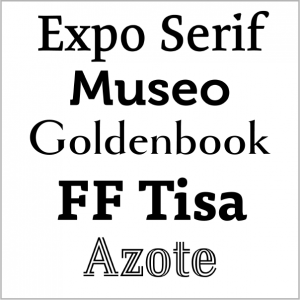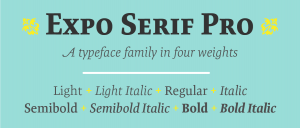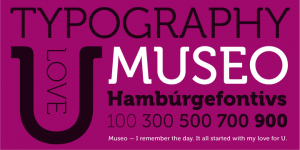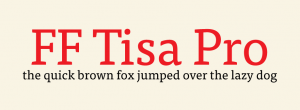Five Distinctive Serifs from Typekit
Serif typefaces are the foundation of typographic communications. They can be seen everywhere from signage, logos, packaging and branding, to web sites and other digital media. Serif typestyles have a broad range of applications, from oversized billboards to very small text. While it is true that there are already thousands of serif designs available in digital form, there is always room for more to create a unique identity and make a statement.
The good news is that more and more of these dependable type designs are available from Typekit via Adobe’s Creative Cloud service, which is how most designers access their favorite Creative Suite apps. Typekit is a subscription font service that brings thousands of fonts from foundry partners into one library for quick browsing, easy use on the web or in applications, and endless typographic inspiration. Most Creative Cloud subscriptions include a Typekit Portfolio plan with access to their full library of fonts, while a few Creative Cloud options include a Typekit Free plan, with a subset of the fonts available.
We reviewed the ever-expanding Typekit Library and have chosen five original serif designs to highlight. They range from large, workhorse superfamilies to a small, boutique three-weight offerings, and were selected for their strength of concept and execution, as well as their originality and usefulness.

Expo Serif Pro
Expo Serif Pro, designed by type designer, graphic designer and educator Mark Jamra, is a workhorse typeface family ideal for the professional font library. Like its companion Expo Sans Pro, this serif version is highly readable and has the ability to project personality without becoming obtrusive, allowing it to perform well in a multitude of tasks and media. One look at Expo Serif Pro reveals that it is much more than merely a clone of Expo Sans Pro with serifs. It was made with the same spirit and expressiveness, but not designed to be an identical twin. Expo Serif Pro combines easily with Expo Sans Pro while maintaining its own warmth and integrity. This design was a winner in the 2009 Type Directors Club typeface design competition.
Museo
Museo, designed by Jos Buivenga for his exljbris Font Foundry, is a semi-serif typeface with lucid, open forms and highly original details – especially the pipe-like, bent half-serifs. It is great for stylish-looking headlines but also very effective in medium-sized texts. This very original, five-weight family all started with the designer’s love for the letter ‘U’. He says, “This uppercase letter just came to me as an image in a daydream. The top of both stems bent into semi-slab serifs. From this principle I worked out the rest of the uppercase letters. My first intention was to make it an all-caps display font, but after a while, I changed my mind. I wanted it to be a bit more versatile, so I decided to add lowercase and adjust spacing and kerning to increase legibility.”
Goldenbook
Goldenbook, designed by Mark Simonson, is based on the logotype of a literary magazine from the late 1920s called The Golden Book Magazine. This three-weight family is an art deco take on the classic Roman letterforms, but with lowercase. Simonson says, “There were only the letters in the logotype to work from, so I used my imagination for the rest. I tried to be true to the period, as if it had been a full font, and not the work of a lettering artist. With its fine features, it is best used large. I don’t know if it’s because of the name, but I see it used most often on book covers.”
FF Tisa
Mitja Miklavcic drew FF Tisa to meet the technological and aesthetic requirements of modern magazine use. His goal was to develop a softer, more dynamic version of a nineteenth-century slab serif wood type. A large x-height and pronounced serifs make this 14 weight family extremely legible in text sizes, and its unique design details and a fairly upright italic become evident in display applications. This typeface was selected by the TDC judges for a Certificate of Excellence in Type Design in 2007.
Azote
Designed by graphic and typeface designer Thomas Jockin, Azote was inspired by the 1968 Mexican Olympics. Azote is a multiline typeface family that uses the addition of lines to add weight rather than stroke thickness. It consists of three roman and three italic versions, with the italics containing some very free-flowing and decorative glyphs. Jockin says, “I love the tough design briefs. A retail typeface is the chance to tackle bigger, and more complex, design problems.” We love his adventurous spirit, and think he nailed this one!
* * * * *
Typekit has these offerings plus hundreds more serif typestyles to choose from. Their library includes new and original designs, as well as beloved historic revivals such as Caslon, Garamond, and Baskerville. Have fun exploring these selections, and then get yourself to the Typekit website library and find your own favorites!









I like them. How do I make them part of my font suitcase?
Are they for sale? At what cost?
Are they offered at no cost?
Who do I contact to obtain them?
Thanks,
JG
Hi John- Check the 2nd paragraph of the article for details of how to get Typekit fonts.
Thanks much for the list. I’m particularly intrigued that you noted that Goldenbook was often used for book covers. I agree that it has a classy, elegant look that’ll probably look marvelous on mine. It’s also Web and Synch, so there will be no licensing issues. I’ve been looking for a what the creator calles a Trajan-like font with lowercase for title pages, so it may serve as well there too. No italic though, although this font may not italicize well.
Here are a wide variety of other fonts from Goldenbook’s creator:
https://www.marksimonson.com/fonts
I do love Simonson’s work, but note his licensing requirements. If you want to use one of his fonts in an eBook, and you get it from Typekit, you can, period. No additional license to buy, no additional fee. Typekit fonts are embeddable in ebooks and can be used in an unlimited number of titles. This is what Simonson’s studio (and other studios) agreed to when they signed on to allow Typekit to distribute their fonts for web or print.
But if you license a font from Simonson’s web site, you are only allowed to use it for print or PDF projects. If you want to use the same font in an ebook, you have to purchase an additional license. He says “My standard ebook embedded font license is a one-time fee per title of US$87 for a single font and US$45 for each additional font licensed at the same time” … note that’s PER TITLE.
Compared to other foundries, that’s actually a bargain. I’ve seen many instances where eBook licensing is a separate $150 to $300 fee per font (that is, style of a typeface), per ebook title. Sometime renewable every year. (!)
I suppose this is a way for type designers to make more money, and more power to ’em. But as a graphic designer who does print, PDF, and digital publication design, it’s a relief to know that my Typekit license allows me to use any of their fonts for any of these purposes for the same monthly subscription cost, which is extremely reasonable.
If you don’t have CC, you can subscribe to the equivalent Portfolio level Typekit subscription for $49.95 a year.
https://typekit.com/plans
A real gem in the selected 5 is EXPO Serif. It’s so difficult to make a classic serif face with contemporary feeling. My vote goes to Mark Jamra!